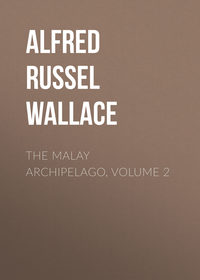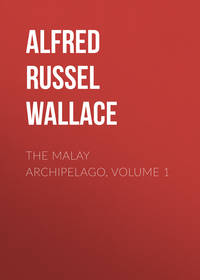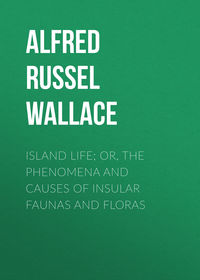 полная версия
полная версияContributions to the Theory of Natural Selection
8. Toucans (Rhamphastidæ). These fine birds are coloured in the most conspicuous parts of their body, especially on the large bill, and on the upper and lower tail coverts, which are crimson, white, or yellow. The sexes are exactly alike, and they always build in a hollow tree.
9. Plaintain-eaters (Musophagidæ). Here again the head and bill are most brilliantly coloured in both sexes, and the nest is in a hole of a tree.
10. Ground cuckoos (Centropus). These birds are often of conspicuous colours, and are alike in both sexes. They build a domed nest.
11. Woodpeckers (Picidæ). In this family the females often differ from the males, in having a yellow or white, instead of a crimson crest, but are almost as conspicuous. They all nest in holes in trees.
12. Parrots (Psittaci). In this great tribe, adorned with the most brilliant and varied colours, the rule is, that the sexes are precisely alike, and this is the case in the most gorgeous families, the lories, the cockatoos, and the macaws; but in some there is a sexual difference of colour to a slight extent. All build in holes, mostly in trees, but sometimes in the ground, or in white ants’ nests. In the single case in which the nest is exposed, that of the Australian ground parrot, Pezoporus formosus, the bird has lost the gay colouring of its allies, and is clothed in sombre and completely protective tints of dusky green and black.
13. Gapers (Eurylæmidæ). In these beautiful Eastern birds, somewhat allied to the American chatterers, the sexes are exactly alike, and are adorned with the most gay and conspicuous markings. The nest is a woven structure, covered over, and suspended from the extremities of branches over water.
14. Pardalotus (Ampelidæ). In these Australian birds the females differ from the males, but are often very conspicuous, having brightly-spotted heads. Their nests are sometimes dome-shaped, sometimes in holes of trees, or in burrows in the ground.
15. Tits (Paridæ). These little birds are always pretty, and many (especially among the Indian species) are very conspicuous. They always have the sexes alike, a circumstance very unusual among the smaller gaily-coloured birds of our own country. The nest is always covered over or concealed in a hole.
16. Nuthatches (Sitta). Often very pretty birds, the sexes alike, and the nest in a hole.
17.– (Sittella). The female of these Australian nuthatches is often the most conspicuous, being white-and black-marked. The nest is, according to Gould, “completely concealed among upright twigs connected together.”
18. Creepers (Climacteris). In these Australian creepers the sexes are alike, or the female most conspicuous, and the nest is in a hole of a tree.
19. Estrelda, Amadina. In these genera of Eastern and Australian finches the females, although more or less different from the males, are still very conspicuous having a red rump, or being white spotted. They differ from most others of the family in building domed nests.
20. Certhiola. In these pretty little American creepers the sexes are alike, and they build a domed nest.
21. Mynahs (Sturnidæ). These showy Eastern starlings have the sexes exactly alike. They build in holes of trees.
22. Calornis (Sturnidæ). These brilliant metallic starlings have no sexual differences. They build a pensile covered nest.
23. Hangnests (Icteridæ). The red or yellow and black plumage of most of these birds is very conspicuous, and is exactly alike in both sexes. They are celebrated for their fine purse-shaped pensile nests.
It will be seen that this list comprehends six important families of Fissirostres, four of Scansores, the Psittaci, and several genera, with three entire families of Passeres, comprising about twelve hundred species, or about one-seventh of all known birds.
The cases in which, whenever the male is gaily coloured, the female is much less gay or quite inconspicuous, are exceedingly numerous, comprising, in fact, almost all the bright-coloured Passeres, except those enumerated in the preceding class. The following are the most remarkable:—
1. Chatterers (Cotingidæ). These comprise some of the most gorgeous birds in the world, vivid blues, rich purples, and bright reds, being the most characteristic colours. The females are always obscurely tinted, and are often of a greenish hue, not easily visible among the foliage.
2. Manakins (Pipridæ). These elegant birds, whose caps or crests are of the most brilliant colours, are usually of a sombre green in the female sex.
3. Tanagers (Tanagridæ). These rival the chatterers in the brilliancy of their colours, and are even more varied. The females are generally of plain and sombre hues, and always less conspicuous than the males.
In the extensive families of the warblers (Sylviadæ), thrushes (Turdidæ), flycatchers (Muscicapidæ), and shrikes (Laniadæ), a considerable proportion of the species are beautifully marked with gay and conspicuous tints, as is also the case in the Pheasants and Grouse; but in every case the females are less gay, and are most frequently of the very plainest and least conspicuous hues. Now, throughout the whole of these families the nest is open, and I am not aware of a single instance in which any one of these birds builds a domed nest, or places it in a hole of a tree, or underground, or in any place where it is effectually concealed.
In considering the question we are now investigating, it is not necessary to take into account the larger and more powerful birds, because these seldom depend much on concealment to secure their safety. In the raptorial birds bright colours are as a rule absent; and their structure and habits are such as not to require any special protection for the female. The larger waders are sometimes very brightly coloured in both sexes; but they are probably little subject to the attacks of enemies, since the scarlet ibis, the most conspicuous of birds, exists in immense quantities in South America. In game birds and water-fowl, however, the females are often very plainly coloured, when the males are adorned with brilliant hues; and the abnormal family of the Megapodidæ offers us the interesting fact of an identity in the colours of the sexes (which in Megacephalon and Talegalla are somewhat conspicuous), in conjunction with the habit of not sitting on the eggs at all.
What the Facts Teach us
Taking the whole body of evidence here brought forward, embracing as it does almost every group of bright-coloured birds, it will, I think, be admitted that the relation between the two series of facts in the colouring and nidification of birds has been sufficiently established. There are, it is true, a few apparent and some real exceptions, which I shall consider presently; but they are too few and unimportant to weigh much against the mass of evidence on the other side, and may for the present be neglected. Let us then consider what we are to do with this unexpected set of correspondences between groups of phenomena which, at first sight, appear so disconnected. Do they fall in with any other groups of natural phenomena? Do they teach us anything of the way in which nature works, and give us any insight into the causes which have brought about the marvellous variety, and beauty, and harmony of living things? I believe we can answer these questions in the affirmative; and I may mention, as a sufficient proof that these are not isolated facts, that I was first led to see their relation to each other by the study of an analogous though distinct set of phenomena among insects, that of protective resemblance and “mimicry.”
On considering this remarkable series of corresponding facts, the first thing we are taught by them seems to be, that there is no incapacity in the female sex among birds, to receive the same bright hues and strongly contrasted tints with which their partners are so often decorated, since whenever they are protected and concealed during the period of incubation they are similarly adorned. The fair inference is, that it is chiefly due to the absence of protection or concealment during this important epoch, that gay and conspicuous tints are withheld or left undeveloped. The mode in which this has been effected is very intelligible, if we admit the action of natural and sexual selection. It would appear from the numerous cases in which both sexes are adorned with equally brilliant colours (while both sexes are rarely armed with equally developed offensive and defensive weapons when not required for individual safety), that the normal action of “sexual selection” is to develop colour and beauty in both sexes, by the preservation and multiplication of all varieties of colour in either sex which are pleasing to the other. Several very close observers of the habits of animals have assured me, that male birds and quadrupeds do often take very strong likes and dislikes to individual females, and we can hardly believe that the one sex (the female) can have a general taste for colour while the other has no such taste. However this may be, the fact remains, that in a vast number of cases the female acquires as brilliant and as varied colours as the male, and therefore most probably acquires them in the same way as the male does; that is, either because the colour is useful to it, or is correlated with some useful variation, or is pleasing to the other sex. The only remaining supposition is that it is transmitted from the other sex, without being of any use. From the number of examples above adduced of bright colours in the female, this would imply that colour-characters acquired by one sex are generally (but not necessarily) transmitted to the other. If this be the case it will, I think, enable us to explain the phenomena, even if we do not admit that the male bird is ever influenced in the choice of a mate by her more gay or perfect plumage.
The female bird, while sitting on her eggs in an uncovered nest, is much exposed to the attacks of enemies, and any modification of colour which rendered her more conspicuous would often lead to her destruction and that of her offspring. All variations of colour in this direction in the female, would therefore sooner or later be eliminated, while such modifications as rendered her inconspicuous, by assimilating her to surrounding objects, as the earth or the foliage, would, on the whole, survive the longest, and thus lead to the attainment of those brown or green and inconspicuous tints, which form the colouring (of the upper surface at least), of the vast majority of female birds which sit upon open nests.
This does not imply, as some have thought, that all female birds were once as brilliant as the males. The change has been a very gradual one, generally dating from the origin of genera or of larger groups, but there can be no doubt that the remote ancestry of birds having great sexual differences of colour, were nearly or quite alike, sometimes (perhaps in most cases) more nearly resembling the female, but occasionally perhaps being nearer what the male is now. The young birds (which usually resemble the females) will probably give some idea of this ancestral type, and it is well known that the young of allied species and of different sexes are often undistinguishable.
Colour more variable than Structure or Habits, and therefore the Character which has generally been Modified
At the commencement of this essay, I have endeavoured to prove, that the characteristic differences and the essential features of birds’ nests, are dependent on the structure of the species and upon the present and past conditions of their existence. Both these factors are more important and less variable than colour; and we must therefore conclude that in most cases the mode of nidification (dependent on structure and environment) has been the cause, and not the effect, of the similarity or differences of the sexes as regards colour. When the confirmed habit of a group of birds, was to build their nests in holes of trees like the toucans, or in holes in the ground like the kingfishers, the protection the female thus obtained, during the important and dangerous time of incubation, placed the two sexes on an equality as regards exposure to attack, and allowed “sexual selection,” or any other cause, to act unchecked in the development of gay colours and conspicuous markings in both sexes.
When, on the other hand (as in the Tanagers and Flycatchers), the habit of the whole group was to build open cup-shaped nests in more or less exposed situations, the production of colour and marking in the female, by whatever cause, was continually checked by its rendering her too conspicuous, while in the male it had free play, and developed in him the most gorgeous hues. This, however, was not perhaps universally the case; for where there was more than usual intelligence and capacity for change of habits, the danger the female was exposed to by a partial brightness of colour or marking might lead to the construction of a concealed or covered nest, as in the case of the Tits and Hangnests. When this occurred, a special protection to the female would be no longer necessary; so that the acquisition of colour and the modification of the nest, might in some cases act and react on each other and attain their full development together.
Exceptional Cases confirmatory of the above Explanation
There exist a few very curious and anomalous facts in the natural history of birds, which fortunately serve as crucial tests of the truth of this mode of explaining the inequalities of sexual colouration. It has been long known, that in some species the males either assisted in, or wholly performed, the act of incubation. It has also been often noticed, that in certain birds the usual sexual differences were reversed, the male being the more plainly coloured, the female more gay and often larger. I am not, however, aware that these two anomalies had ever been supposed to stand to each other in the relation of cause and effect, till I adduced them in support of my views of the general theory of protective adaptation. Yet it is undoubtedly the fact, that in the best known cases in which the female bird is more conspicuously coloured than the male, it is either positively ascertained that the latter performs the duties of incubation, or there are good reasons for believing such to be the case. The most satisfactory example is that of the Gray Phalarope (Phalaropus fulicarius), the sexes of which are alike in winter, while in summer the female instead of the male takes on a gay and conspicuous nuptial plumage; but the male performs the duties of incubation, sitting upon the eggs, which are laid upon the bare ground.
In the Dotterell (Eudromias morinellus) the female is larger and more brightly coloured than the male; and here, also, it is almost certain that the latter sits upon the eggs. The Turnices of India also, have the female larger and often more brightly coloured; and Mr. Jerdon states, in his “Birds of India,” that the natives report, that, during the breeding season, the females desert their eggs and associate in flocks, while the males are employed in hatching the eggs. In the few other cases in which the females are more brightly coloured, the habits are not accurately known. The case of the Ostriches and Emeus will occur to many as a difficulty, for here the male incubates, but is not less conspicuous than the female; but there are two reasons why the case does not apply;—the birds are too large to derive any safety from concealment, from enemies which would devour the eggs they can defend themselves by force, while to escape from their personal foes they trust to speed.
We find, therefore, that a very large mass of facts relating to the sexual colouration and the mode of nidification of birds, including some of the most extraordinary anomalies to be found in their natural history, can be shown to have an interdependent relation to each other, on the simple principle of the need of greater protection to that parent which performs the duties of incubation. Considering the very imperfect knowledge we possess of the habits of most extra-European birds, the exceptions to the prevalent rule are few, and generally occur in isolated species or in small groups; while several apparent exceptions can be shown to be really confirmations of the law.
Real or apparent Exceptions to the Law stated at page 240
The only marked exceptions I have been able to discover are the following:—
1. King crows (Dicrourus). These birds are of a glossy black colour with long forked tails. The sexes present no difference, and they build open nests. This apparent exception may probably be accounted for by the fact that these birds do not need the protection of a less conspicuous colour. They are very pugnacious, and often attack and drive away crows, hawks, and kites; and as they are semi-gregarious in their habits, the females are not likely to be attacked while incubating.
2. Orioles (Oriolidæ). The true orioles are very gay birds; the sexes are, in many Eastern species, either nearly or quite alike, and the nests are open. This is one of the most serious exceptions, but it is one that to some extent proves the rule; for in this case it has been noticed, that the parent birds display excessive care and solicitude in concealing the nest among thick foliage, and in protecting their offspring by incessant and anxious watching. This indicates that the want of protection consequent on the bright colour of the female makes itself felt, and is obviated by an increased development of the mental faculties.
3. Ground thrushes (Pittidæ). These elegant and brilliantly-coloured birds are generally alike in both sexes, and build an open nest. It is curious, however, that this is only an apparent exception, for almost all the bright colours are on the under surface, the back being usually olive green or brown, and the head black, with brown or whitish stripes, all which colours would harmonize with the foliage, sticks, and roots which surround the nest, built on or near the ground, and thus serve as a protection to the female bird.
4. Grallina Australis. This Australian bird is of strongly contrasted black and white colours. The sexes are exactly alike, and it builds an open clay nest in an exposed situation on a tree. This appears to be a most striking exception, but I am by no means sure that it is so. We require to know what tree it usually builds on, the colour of the bark or of the lichens that grow upon it, the tints of the ground, or of other surrounding objects, before we can say that the bird, when sitting on its nest, is really conspicuous. It has been remarked that small patches of white and black blend at a short distance to form grey, one of the commonest tints of natural objects.
5. Sunbirds (Nectarineidæ). In these beautiful little birds the males only are adorned with brilliant colours, the females being quite plain, yet they build covered nests in all the cases in which the nidification is known. This is a negative rather than a positive exception to the rule, since there may be other causes besides the need for protection, which prevent the female acquiring the gay colours of her mate, and there is one curious circumstance which tends to elucidate it. The male of Leptocoma zeylanica is said to assist in incubation. It is possible, therefore, that the group may originally have used open nests, and some change of conditions, leading the male bird to sit, may have been followed by the adoption of a domed nest. This is, however, the most serious exception I have yet found to the general rule.
6. Superb warblers (Maluridæ). The males of these little birds are adorned with the most gorgeous colours, while the females are very plain, yet they make domed nests. It is to be observed, however, that the male plumage is nuptial merely, and is retained for a very short time; the rest of the year both sexes are plain alike. It is probable, therefore, that the domed nest is for the protection of these delicate little birds against the rain, and that there is some unknown cause which has led to the development of colour in the males only.
There is one other case which at first sight looks like an exception, but which is far from being one in reality, and deserves to be mentioned. In the beautiful Waxwing, (Bombycilla garrula,) the sexes are very nearly alike, and the elegant red wax tips to the wing-feathers are nearly, and sometimes quite, as conspicuous in the female as in the male. Yet it builds an open nest, and a person looking at the bird would say it ought according to my theory to cover its nest. But it is, in reality, as completely protected by its colouration as the most plainly coloured bird that flies. It breeds only in very high latitudes, and the nest, placed in fir-trees, is formed chiefly of lichens. Now the delicate gray and ashy and purplish hues of the head and back, together with the yellow of the wings and tail, are tints that exactly harmonize with the colours of various species of lichens, while the brilliant red wax tips exactly represent the crimson fructification of the common lichen, Cladonia coccifera. When sitting on its nest, therefore, the female bird will exhibit no colours that are not common to the materials of which it is constructed; and the several tints are distributed in about the same proportions as they occur in nature. At a short distance the bird would be indistinguishable from the nest it is sitting on, or from a natural clump of lichens, and will thus be completely protected.
I think I have now noticed all exceptions of any importance to the law of dependence of sexual colour on nidification. It will be seen that they are very few in number, compared with those which support the generalization; and in several cases there are circumstances in the habits or structure of the species that sufficiently explain them. It is remarkable also that I have found scarcely any positive exceptions, that is, cases of very brilliant or conspicuous female birds in which the nest was not concealed. Much less can there be shown any group of birds, in which the females are all of decidedly conspicuous colours on the upper surface, and yet sit in open nests. The many cases in which birds of dull colours in both sexes make domed or concealed nests, do not, of course, affect this theory one way or the other; since its purpose is only to account for the fact, that brilliant females of brilliant males are always found to have covered or hidden nests, while obscure females of brilliant males almost always have open and exposed nests. The fact that all classes of nests occur with dull coloured birds in both sexes merely shows, as I have strongly maintained, that in most cases the character of the nest determines the colouration of the female, and not vice versâ.
If the views here advocated are correct, as to the various influences that have determined the specialities of every bird’s nest, and the general colouration of female birds, with their action and reaction on each other, we can hardly expect to find evidence more complete than that here set forth. Nature is such a tangled web of complex relations, that a series of correspondences running through hundreds of species, genera, and families, in every part of the system, can hardly fail to indicate a true casual connexion; and when, of the two factors in the problem, one can be shown to be dependent on the most deeply seated and the most stable facts of structure and conditions of life, while the other is a character universally admitted to be superficial and easily modified, there can be little doubt as to which is cause and which effect.
Various modes of Protection of Animals
But the explanation of the phenomenon here attempted does not rest alone on the facts I have been able now to adduce. In the essay on “Mimicry,” it is shown how important a part the necessity for protection has played, in determining the external form and colouration, and sometimes even the internal structure of animals.
As illustrating this latter point, I may refer to the remarkable hooked, branched, or star-like spiculæ in many sponges, which are believed to have the function chiefly, of rendering them unpalatable to other creatures. The Holothuridæ or sea-cucumbers possess a similar protection, many of them having anchor-shaped spicules embedded in their skin, as the Synapta; while others (Cuviera squamata) are covered with a hard calcareous pavement. Many of these are of a bright red or purple colour, and are very conspicuous, while the allied Trepang, or Beche-de-mer (Holothuria edulis), which is not armed with any such defensive weapons, is of a dull sand-or mud-colour, so as hardly to be distinguished from the sea bed on which it reposes. Many of the smaller marine animals are protected by their almost invisible transparency, while those that are most brightly coloured will be often found to have a special protection, either in stinging tentacles like Physalia, or in a hard calcareous crust, as in the star fishes.









